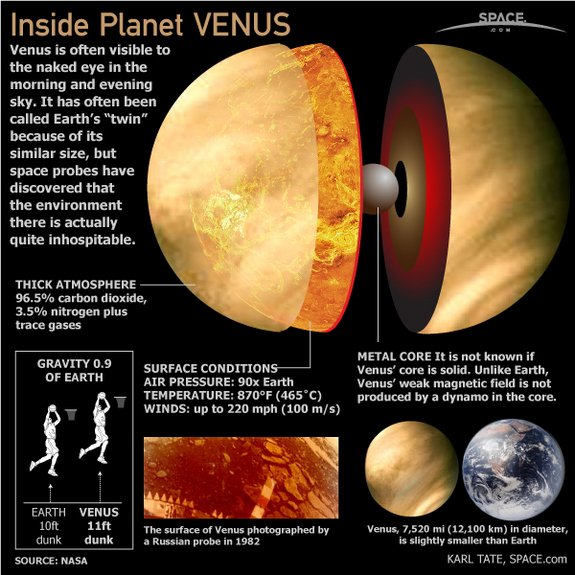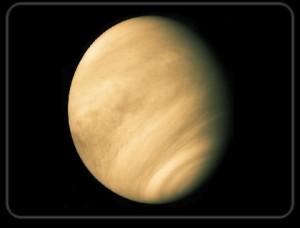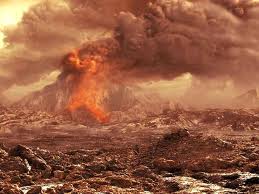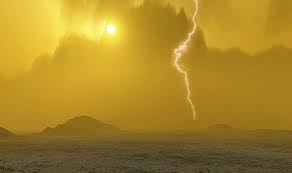Planet Venus


Often called “Earth’s twin” or “Earth’s sister planet,” Venus is the terrestrial, or rocky, planet that is closest to Earth in size, gravity, and composition. It can be seen in the sky shortly after sunset or before sunrise and is typically one of the first “stars” to appear. For this reason, it is called the “morning star” and “evening star.” Venus is the second planet from the sun and, because it is closer to the sun than Earth, it can be seen going through phases with a telescope. It was named for the Roman goddess of love and beauty.
A Look At Venus
Venus By The Numbers
- Orbital period: 224.68 Earth days. One Venus year equals 0.615 Earth years.
- Period of rotation: 243.01 Earth days
- Average distance from sun: 1.082 X 10^8 km (0.7233 Astronomical Units)
- Diameter at equator: 12,104 km (95% the diameter of Earth)
- Mass: 4.870 X 10^24 km (81.5% the mass of Earth)
- Average density: 5.24 g/cm^3
- Surface gravity: 0.903 G (Earth gravity = 1 G)
- Escape velocity: 10.3 km/s (92% of Earth)
- Surface temperature: 745 K (472 degrees Celsius, or 882 degrees Farenheit)
- Apparent magnitude: -4.6 Venus is the second brightest object in the night sky, after the Moon.
Venus’ Retrograde Rotation
Venus is weird because it rotates “backwards” compared to most of the other planets in the solar system. One theory explaining this says that, when Venus was a young protoplanet, a large object smashed into it, upsetting its rotation. Another theory says that solar tides in its atmosphere gradually caused it to start spinning backwards.
Geography of Venus

For a very long time, the surface of Venus was a mystery due to Venus’s heavy cloud cover. As a result, it was often fair game for science fiction writers, who imagined a variety of landscapes from swamps to vast oceans. The truth is that Venus has neither because it has no surface water, a result of its proximity to the sun and runaway greenhouse effect.
Interesting geographic features on Venus include the mountain Maxwell Montes, which is one and a half times the height of Mount Everest. Discovered during Earth-based radar mapping of Venus, it was named for James Clark Maxwell, the physicist who first described electromagnetic radiation. Most of this planet’s surface has features with a feminine naming convention, including Ishtar Terra and Aphrodite Terra, named for the Babylonian and Greek goddesses of love.
Much of Venus is covered with basalt rock, which indicates volcanic activity. Many of the over 1600 volcanoes appear to be extinct. However, Venus’ highest volcano, Maat Mons, shows signs of recent eruptions. Because Venus has no noticeable tectonic activity, most of the volcanoes are shield volcanoes that do not move much over the planet’s surface and build up over time. They can cover hundreds of kilometers and are mostly relatively flat.
Atmosphere of Venus

A lot of people think of Venus as a planet gone wrong because its atmosphere is so drastically different from Earth’s. Some environmentalists point to Venus as an example of what can happen if greenhouse gases are allowed to get out of control. However, one astronomer had this to say about it:
“No, Venus is probably a fairly normal planet. It is Earth that is peculiar. The universe probably contains more planets like Venus than like Earth.”
About 96% of Venus’ atmosphere is carbon dioxide. Most of the rest is nitrogen at 3.5%, followed by water vapor, sulfuric acid, hydrochloric acid, and hydrofluric acid.
Venus’ cloud layer is composed of sulfuric acid droplets and microscopic sulfur crystals. Probes from Soviet and American spacecraft detected that the clouds on Venus are higher and more stable than those on Earth. Clouds can extend between 58 and 68 kilometers above Venus’ surface, as opposed to no higher than 16 kilometers on Earth. This is because Venus’ atmosphere circulates much more regularly than Earth’s.
This cloud cover contributes to Venus’ greenhouse effect. Surface temperatures can reach 745 Kelvin (472 degrees Celsius or 882 degrees Farenheit). This is the reason there is no surface water on Venus, though there are signs that Venus had oceans in the distant past. Because there are no oceans, the carbon dioxide in the atmosphere could not dissolve. Carbon dioxide is a greenhouse gas, so the effect fed back on itself until the oceans evaporated and the water vapor was broken up by radiation. Because Venus is 30 percent closer to the sun than Earth, it is believed that the more intense radiation Venus received from the sun started this cycle while Earth was lucky enough to escape it.
Exploration of Venus
Many interplanetary probes have taken a look at Venus, ranging from landers to flybys by probes who were headed elsewhere in the solar system. Will humans ever stand on Venus’ surface? Probably not without a lot of protection because Venus’ atmosphere is both toxic and highly corrosive.








